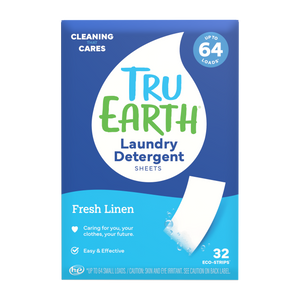We spend a lot our lives in bed – almost a third – and it’s time not always spent asleep. Beds are a place of comfort; a place to curl up and watch TV or sweep through the pages of a book. Beds are a place we take refuge in when sick, burrowed in blankets tucked tight to the chin. Some folks bed-share with pets, others with babies. With all this living comes blood, sweat and tears, pet hair, crumbs, et al. Luckily, washing bed sheets tends to be an unfussy chore with a wonderful payoff: freshly-laundered-linen-feels. Here’s the best way to wash, treat, brighten and store bed sheets.
What wash setting should you launder bed sheets on?
Since people spend more time wrapped in their bed sheets than wearing a single outfit, each wash should offer a thorough clean. From hot flashes to middle-of-the-night potty training accidents, you want to wash bed sheets on the hottest water temperature that is appropriate for the fabric type they’re made of. Why? Hot water does a better job of combating germs, bacteria and dust mites. If you’re worried about the latter, most bed sheets are made of material that can tolerate an iron – so, steam away.
How often should you wash bed sheets?
Generally speaking, once every seven to fourteen days. If you have pets, tend to “sleep hot” or if you like to snack in bed, wash sheets once a week – or even more frequently.
Note: If you suffer from acne, are prone to drooling or come down with a cold/flu, you may want to change your pillowcase daily.
How to wash bed sheets in five simple steps:
Step 1: If washing your bed sheets with clothing, sort them with similar colours first.
Step 2: Inspect the garment care label to remind yourself which wash temperature to choose. Cotton sheets can typically be washed in hot water while cotton-polyester blends and microfibre do just fine in warm. Sheets that may require special care include materials like bamboo, silk and linen.
Step 3: Load the drum, but not too full; garments need room to tumble and rinse. Full loads should only occupy three-quarters of the drum; half-loads should be half-full and small loads, just a quarter.
Step 4: It’s time to wash so toss a Tru Earth laundry detergent eco-strip into the drum or tear into small pieces and place in the soap tray. Initiate the wash cycle.
Step 5: Hang-dry your sheets on a clothesline or in your home, if time permits. Otherwise, run them through the dryer with some wool dryer balls on medium heat.
How to treat stains on bed sheets
Let’s face it, there are a litany of ways bed sheets become soiled that we won’t get into. Tackle most stains by spot-treating with a concentrate of Tru Earth.
How to create a stain concentrate using Tru Earth:
First, tear a strip into small pieces and place in a shallow bowl. Add a tablespoon (15ml) of tap-hot water to begin dissolving it. Stir with a spoon to form a paste, adding small volumes of water as needed. Smear the concentrate atop the stain, gently pressing the mixture into it. Allow the concentrate to sit for 20 minutes. Toss right into the wash – no need to rinse.
For blood stains, rinse immediately with cold water.
How to brighten dull or yellowing bed sheets
There are a few ways to “brighten” dull sheets after the fact, but to start, you’ll want to ensure you’re separating darks from colours and lights to avoid gradual discolouration caused by dye bleed. Otherwise:
- Wash with a booster. Add half a cup of baking soda to the wash cycle.
- Pre-treat using the Tru Earth stain concentrate described above.
- Dry in the sun. Sun-bleaching is a popular recommendation for chemical-free lightening. You probably won’t see radical results, but this method is gentle on linens and you will save on your energy bill.
-
Add some oxygen-bleach. Refresh deep-set discolouration and combat yellowing bed sheets by soaking items in oxygen bleach, following the manufacturer’s instructions. The upside of oxygen bleach is that most fabrics can tolerate it. The big downside: this product is not easily found in zero-waste packaging.
I want my sheets to smell good. What natural options exist?
On the whole, we don’t recommend using dryer sheets or fabric softeners which simply coat fibres in liquid chemical solutions. We recommend applying a few drops of essential oil to wool dryer balls and tossing into the dryer with bed sheets. If you’re hang-drying, simply blend the essential oil with water and spritz while still damp.
How should bed sheets be stored?
Bed sheets should be stored in a dry, cool place away from direct sunlight. Avoid sealing in non-porous containers like bins with tight-fitting lids. It’s also handy to store matching sets together, enclosing the flat sheet and pillowcases with the top sheet into a tidy parcel.
Last, don’t forget to clean your pillows.
Free Shipping*

